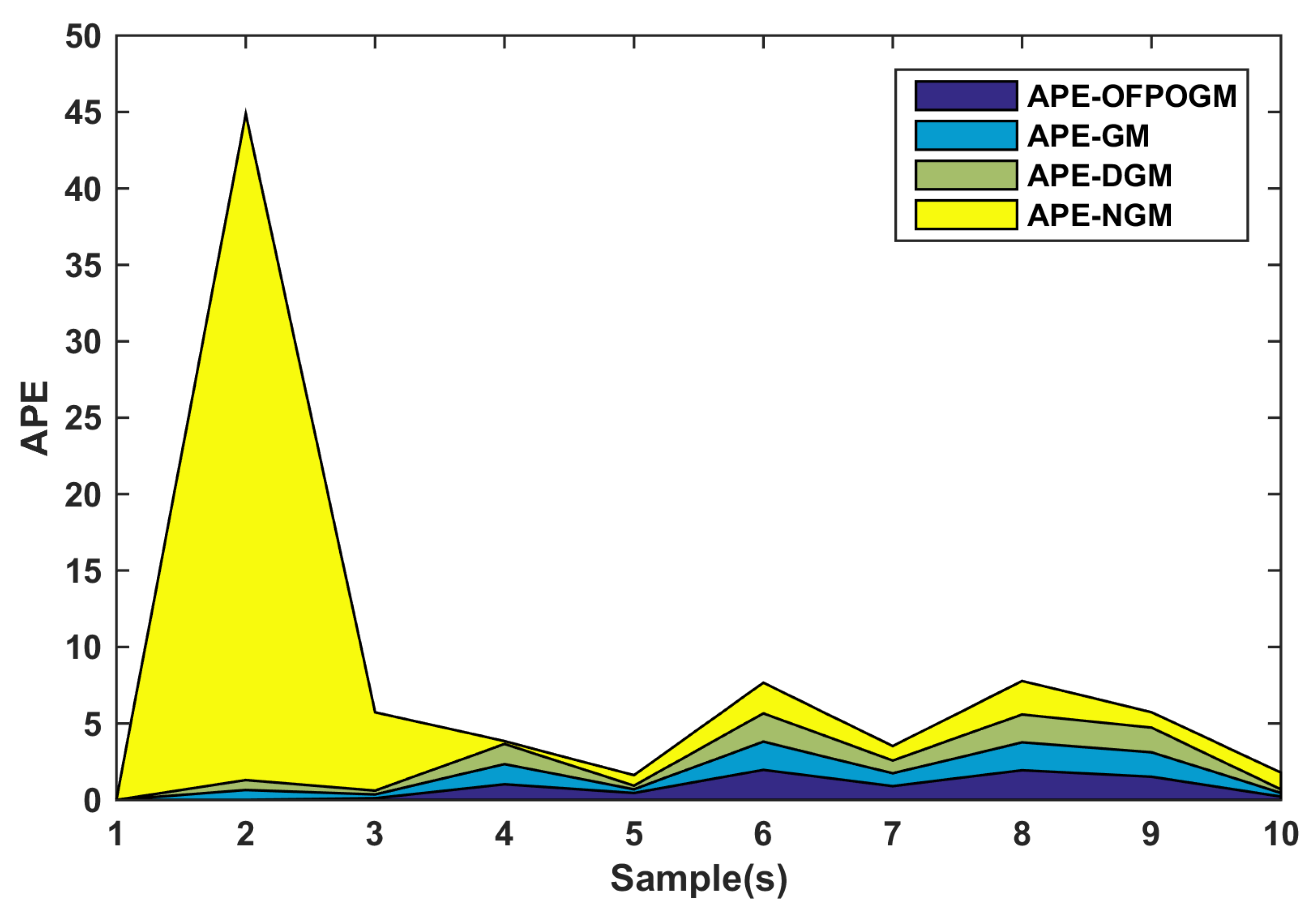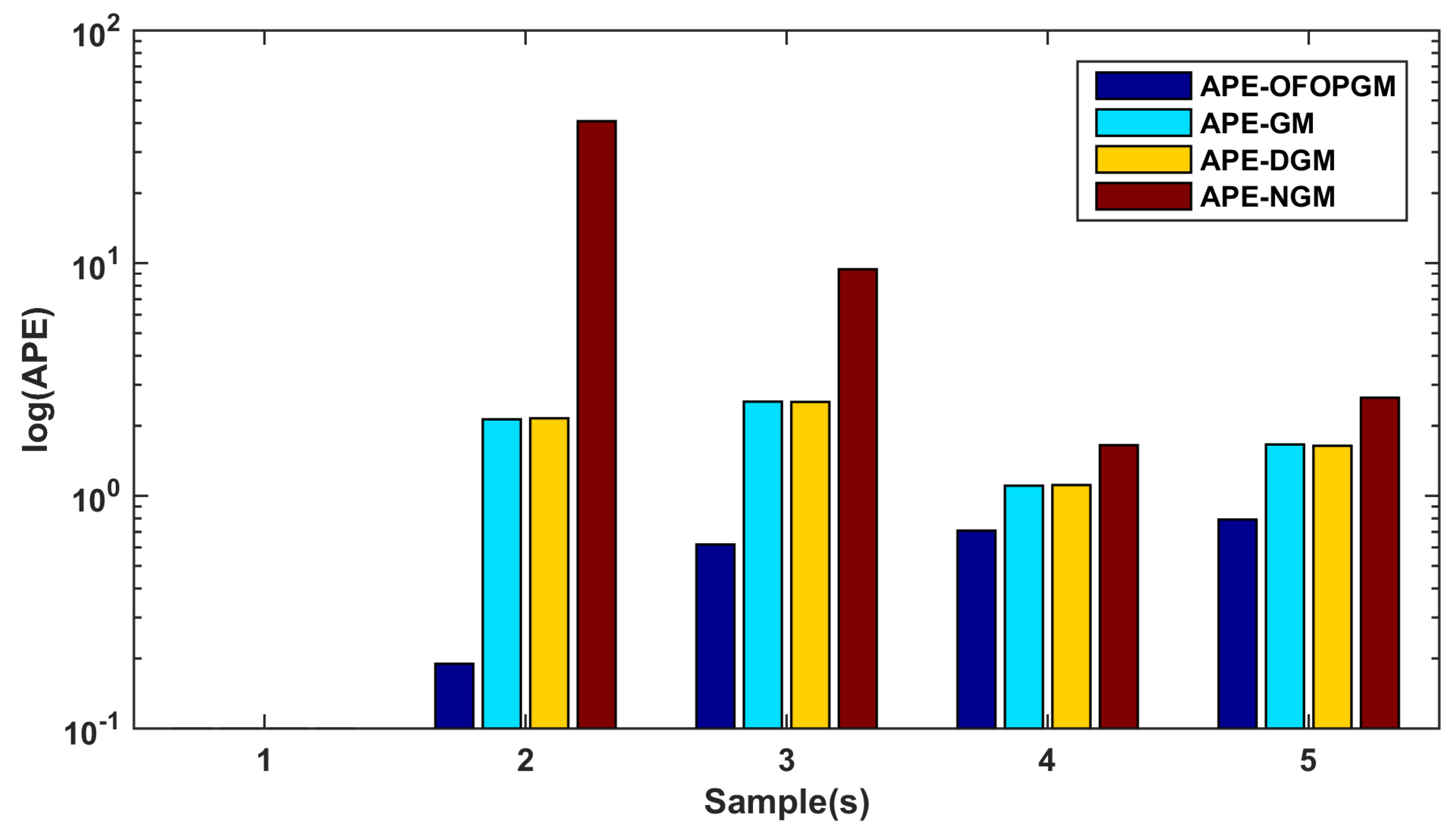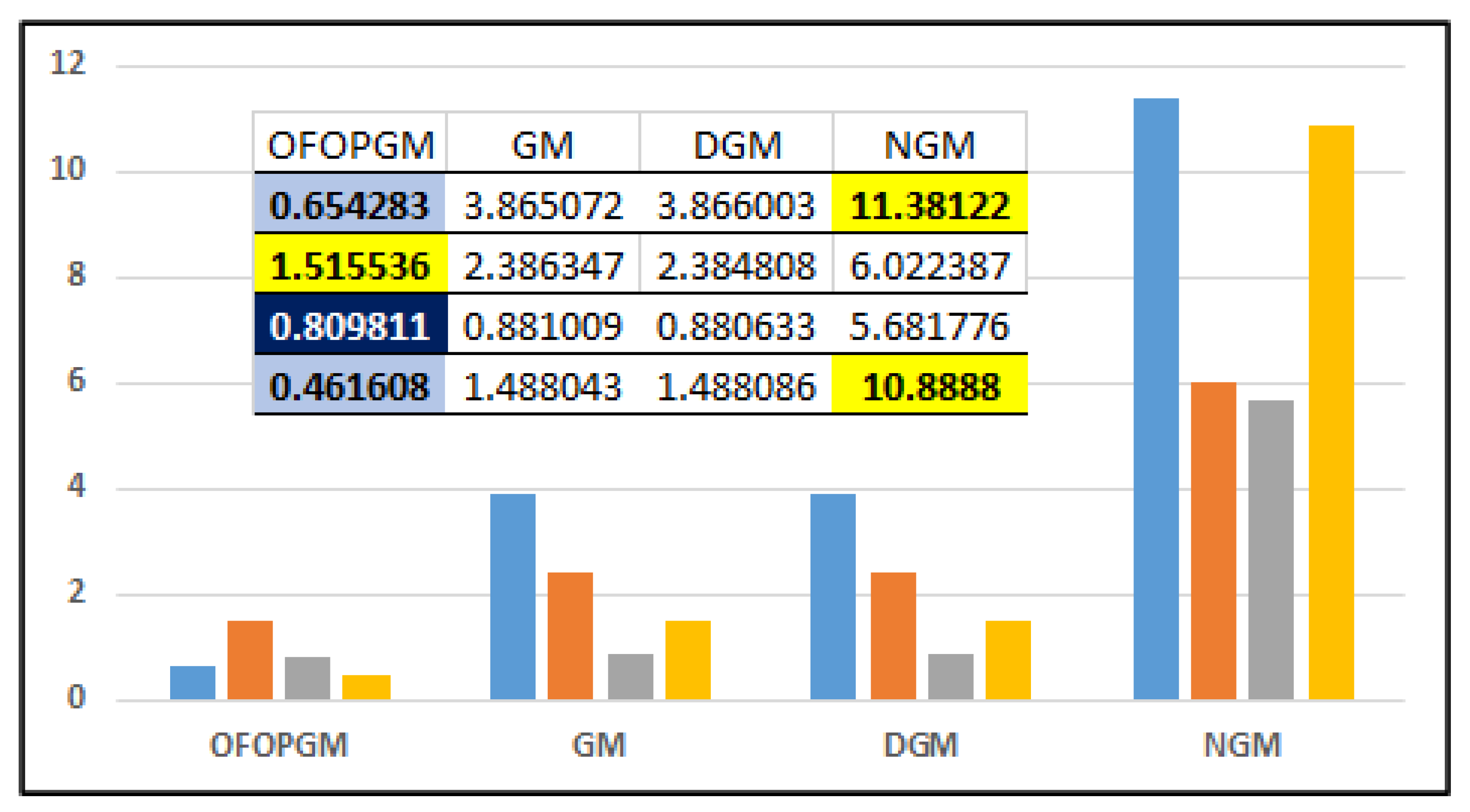1. Introduction
Accurate estimation of energy generation, energy consumption and greenhouse gas emissions can determine a path for sustainable development of any country. Out of these three factors, two factors are generally monotonically increasing functions, i.e., (generation and consumption). Additionally, these are sometimes nonlinear functions that depend upon several conditions, such as political decisions, consumer-oriented policy, demand-based programs and energy conservation policies. In such a case, forecasting of these parameters becomes quite crucial. First, the non-linearity plays a crucial role, and secondly, limited data availability becomes a hurdle in the prediction.
The systems having such partial known characteristics are characterized as grey systems [
1]. These systems are difficult to model and sometimes yield pretty erroneous results. Hence, during the last two decades, the research has focused on the development of a robust framework for grey architecture. In reference [
2], a novel Bernoulli grey model was presented for forecasting the consumption of renewable energy. Another very interesting approach pertaining to the forecasting of renewable energy consumption has been showcased in the reference [
3]. The latest research showcases the prediction of energy price with cubic polynomial realization [
4]. In this work, the authors provided a cubic polynomial-based realization for market-clearing price prediction. Another important study integrating metaheuristics and grey mathematics was reported in reference [
5]. The research showcased an amalgamation of a metaheuristic algorithm for parameter optimization of a whitening equation for market-clearing price prediction. The research focused on the fact that the accuracy of prediction engines can be enhanced with the applications of optimization. Applications of some optimized devices have also been investigated in the work [
6]. Likewise, for modeling of carbon dioxide emissions, different intelligent methods are discussed in reference [
7]. Optimization approaches require statistical comparisons; hence, a novel approach has been addressed in reference [
8]. This model employs an extended deep statistical comparison to compare the optimization performance of metaheuristics. A novel adaptive structure has been implemented in reference [
9] for prediction of crude oil production in China. The approach employed a fractional-order grey model along with grey wolf optimization (GWO) for implementation. Reference [
10] employed the concept of weighted fractional accumulation generation in the prediction of natural gas production. The authors employed five distinct nature inspired optimization algorithms in this work. A seasonal variation index has been proposed for consumption of the residential electricity consumption. The authors claimed that this integration can bring speed to forecasting [
11]. An application of the cuckoo search for forecasting the consumer demand in the New South Wales area was conducted in reference [
12]. In this work, a single parameter was optimized by the algorithm. Another very interesting approach with this algorithm can be seen in reference [
13]. The algorithm was employed to predict thermal error compensation for CNC machine tools.
It is also worth mentioning here that integration of a grey architecture with optimization algorithms for tuning the parameters is also a potential area of research. In reference [
14], a rolling grey model was proposed for economic prediction with the help particle swarm optimization (PSO). It is worth mentioning here that PSO is still the most suitable algorithm for nonlinear functions. Further, in reference [
15], a very interesting prediction was executed for sales and stock piling of electric vehicles using an adaptive optimized grey model. From these approaches, it is evident that research is aggregating towards the adaptive and optimized model as compared to rigid, fixed-structure grey models. The inverse square reverse unit (ISRU) activation function has been integrated with the grey model to forecast power consumption in China. This function helps to explain data growth, and this yields high accuracy in the predictions [
16]. Likewise, an integration of the grasshopper optimization algorithm (GOA) and the time-delayed grey model has been presented in reference [
17], and its applications in the prediction have been reported prominently.
On the basis of this discussion, the following research objectives are framed. The outcomes of this research were evaluated with the help of the framework proposed to reach these objectives.
To discuss the mathematical framework of the proposed nonlinear-kernel-based implementation and develop an optimization routine for estimating parameters of the nonlinear whitening equation.
To assure applicability of this realization for the prediction of energy generation, consumer demand, and forecasting of CO emissions.
To employ the augmented crow search algorithm (ACSA) for optimizing the parameters of this framework and evaluate the framework by the calculation of various error indices, such as absolute percentage error and the mean of this error.
The remaining part of the paper is organized as follows.
Section 2 presents a development model of OFOPGM and mathematical details of the naïve grey model.
Section 3 showcases the optimization capabilities of the augmented crow search algorithm and establishes the efficacy and implementation details of the ACSA for the parameter-estimation process.
Section 4 presents analysis of the results for the proposed approach and comparative analysis with other conventional grey models for predictions of various parameters. Finally, all major findings are summarized in a lucid form in
Section 5. Some future research directions are also chalked out with reference to our experimentation.
2. Development of a Grey Model Based on the Optimized Fractional Overhead Power Term Polynomial Grey Model (OFOPGM)
The model based on optimized whitening equation has been presented in reference [
5]. The model has been employed for the prediction of the market-clearing price for energy trading. The model has been tested for various datasets of market-clearing price. The efficacy of the model for dealing with nonlinear data became a primary reason to employ it for this work.
Theorem 1. The representative expression for time series for energy generation, energy consumption and related to CO emissions can be cumulatively represented by the following notation:andrepresents the series obtained after one time accumulation; is the background value. The basic form of an optimized grey model is proposed aswhere a is the development coefficient and is stochastic grey action quantity. Here, α and β are design parameters, which are computed through an optimization process. Now, the system can be represented as Proof of Theorem 1. The whitening equation integration between the interval
is
From the expression for inverse accumulation, the original values can be obtained from accumulated values and can be expressed as:
and part of the expression (11) can be appended from trapezoidal rule application; i.e.,
by substituting the expressions from (
5) and (
6) in expression (
4), the theorem can be proved.
□
Theorem 2. The parameters of whitening equation can be given by a least-square algorithm: whereand B can be expressed as Proof. By considering the expression (
7), we substitute in
.
Now by substituting with
With the application of mathematical induction, we can write the same expression for
:
By converting the expressions (
9)–(
11), the matrix form of these equations (for
can be obtained, and a solution of the least-square algorithm can be found.
□
After calculating the coefficient of the whitening equation, the response of the forecaster has been evaluated with the help of the following equation.
Here, in this equation, the parameters
and
are adaptive and computed with the help of an optimization routine. For establishing an optimized framework, let us define the error (mean absolute percentage error (MAPE)) as per the following expression:
where
is the predicted output by the forecaster, and
is the actual value of the corresponding
sample. Further the optimization routine has been established considering the cumulative values of all the samples in forecasting. In most of the forecasting approaches, the MAPE index is chosen.
The objective function is defined as per Equation (
15), where the variables are optimized with the help of an optimization algorithm and a fixed structure of whitening equation is obtained. Readers are directed to reference [
5] for proof of Equation (
13).
4. Results
For showcasing the efficacy of the proposed non-linear framework, four case studies were chosen, and predictions were made. The following four case studies were considered.
Case study 1—carbon dioxide emission [23]: The author of reference [
23] developed a forecasting model for prediction of carbon dioxide emission in Vietnam. In addition to that, the same models were applied for prediction of the generation forecast. The analysis was performed for the years 2010–2019. Case studies 1–4 were conducted with the data of the reference.
Case study 2—carbon dioxide emission [24]: An exponential grey forecasting model was deployed for the forecasting of carbon dioxide emissions in Taiwan during 2002 to 2012.
Case study 3—energy generation forecast [25]: The data were taken from the reference, where a foe was developed for 5.6 kW grid-connected PV-system generation data in Beijing from 1997 to 2006. The forecast was conducted with the help of a conventional grey model, along with grey Markov models.
Case study 4—energy consumption forecast [23]: The energy consumption data of Vietnam were taken for the analysis.
To compare the proposed framework to others, three conventional grey models were employed. The first one was a conventional grey model that was formed on the basis of research presented in reference [
26]. A comparison was made with discrete and novel grey forecasting models presented in references [
27,
28]. The results of case study 1 are depicted in
Table 1, which show a case comparison of the proposed framework with the conventional grey model, DGM and NGM. When inspecting the values of error depicted in table, it is evident to say that the MAPE (0.65) is optimal for the proposed grey framework and other forecasts contain high values of errors. It is worth mentioning here that for this particular case, NGM gives very high values of error (11.38). The best values and worst values both are highlighted. The significance of the grey model is seen by the fact that when the data points were limited, it could still generate a fair forecast. From here, it can be observed that with five data values, it can generate an accurate forecast.
In addition to the MAPE values, error and absolute percentage error (APE) are also shown in the tables. From these values, it is clear that the forecast is not very far from the actual values for the proposed framework. Hence, it can be concluded that the proposed framework is able to conduct forecasts in an efficient manner.
Similar results were witnessed when case study 2 was evaluated. The prediction results of the case study are showcased in
Table 2. Here also, the MAPE values are quite optimal for the proposed framework (1.515536). However, unlike the previous case, the performance of NGM (6.02) was not compromised much. From this, it is concluded that the performances of the grey models are quite sensitive to data characteristics. Hence, it can also be seen that to have good forecasting performance, the forecaster should be able to handle the data in a very efficient manner, like the proposed framework.
While inspecting the forecasting performance of the engine for case 3, especially for forecasting the energy generation,
Table 3 shows the obtained results. The pictorial representation of APE is showcased with the help of
Figure 1. The x axis of the figure showcases the no. of datapoints, and on the y axis, the APE is shown. It can be observed that again, the NGM gives pessimistic results, but the proposed framework outperforms the other model, achieving high accuracy. Hence, it is concluded that the proposed optimal framework is meaningful, and it can conduct forecasts with higher accuracy. Further, similar results were obtained for case 4. The results are depicted with the help of
Table 4 and
Figure 2. The x axis of the figure showcases the no. of datapoints, and on the y axis, the APE is shown.












